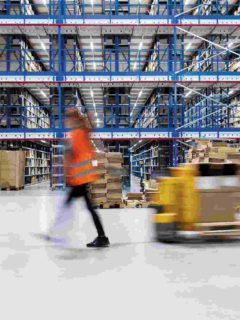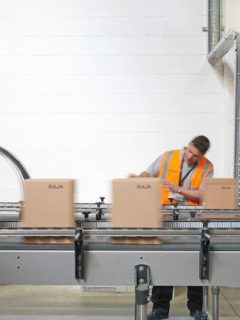As an e-tailer, you see competition increasing all the time – not to mention the internationalisation of consumer purchasing practices, which further increases the need to differentiate yourself.
Nowadays, it’s not enough to offer good products at attractive prices to be competitive.
Your customers expect optimum quality of service, from the moment they order your product to the moment they receive it – or even the moment it is returned to your warehouse.
This is where a key element of your business strategy comes into play : your logistics management.
To help you with this complex task, here’s a complete guide to help you optimise every aspect of your supply chain as an e-commerce logistics manager.
What is logistics management?
Logistics management is the strategy for improving the performance of a company’s supply chain. It is also often referred to as supply chain management.
There are generally five stages in a supply chain – and each of these stages requires a management and optimisation strategy to be put in place:
- Supply (of raw materials to create the product sold, or of finished products to be sold directly)
- Stock management
- Order preparation, including picking and packing of goods
- Distribution and/or transport of goods
- Reverse logistics, i.e. managing customer returns and/or recycling goods
As your business grows, logistics management becomes more complex, with the management of flows and goods becoming increasingly difficult.
Here, you can focus in turn on these different stages, to succeed in improving them all to achieve a hyper-performing e-commerce supply chain.
How can you optimise your supply strategy?
At this stage of the supply chain, the aim of your logistics management strategy is to prevent stock-outs or, conversely, over-stocking, which leads to excessive logistics costs. To do this, you need to determine the quantity of each product to be held in stock at any one time.
Many companies base this on their previous financial years, identifying any seasonal peaks that may have occurred.
But there is also a mathematical formula that can help you determine how much stock you should always have. This is the Wilson formula, also known as the Economic Order Quantity (EOQ). It is used to define the optimum balance of your stocks, which is achieved when each order placed reduces the cost of warehousing, while avoiding stock-outs.
This formula takes into account three key indicators:
- Product demand in terms of quantity over the period (D)
- The cost of an order, which must include the transport of goods (CC)
- The unit cost of ownership of products in stock (CUS)
With these three indicators in hand, you can calculate your economic order quantity as follows:
![]()
But don’t forget to keep a safety stock. To do this, you need to determine the threshold at which you need to restock a product. This safety stock will enable you to avoid any stock-outs – and therefore any potential customer dissatisfaction from a supply point of view.
How can you manage your stocks better?
Good logistics management also requires you to manage your stocks in real time, so that you can respond effectively to customer demand and keep a close eye on your business.
This is wherea storage method tailored to your business is crucial.
There are generally three types of warehousing:
- The LIFO method, where your most recently entered goods are stored furthest away in your warehouse – ideal for storing perishable goods.
- The FIFO method, which is the exact opposite of the LIFO method, and stores the most recent products as close as possible to the packaging space.
- The ABC method, which uses the turnover rate of your products to position them in the warehouse: those that are ordered most frequently are stored closest to the order-picking stations.
To find out more, read our article on this subject.
If you have a very large stock, it’s also crucial to have a WMS (Warehouse Management System) if you don’t already have one. This is software that allows you to manage your stocks and take inventory in a simple way, so that you have a precise overview of the state of your stocks at all times.
How can you improve your order preparation?
To boost your order preparation, you need to define a logistics strategy for two key phases in the supply chain: the picking phase and the packaging phase.
The picking phase
Implementing a logistics picking strategy means first and foremost limiting the rate of order errors, which can damage your customer experience, but also ensuring that products are selected quickly in the warehouse.
To improve the logistics management of this phase, take care to :
- Label your warehouse properly. Label your racks and shelving, as well as the different areas of your warehouse, so that your operators can find your products quickly and easily.
- Equip your operators with the right equipment. Rolls, constant level trolleys, basket trolleys, and even pallet trucks and forklift trucks are just some of the equipment that will enable your operators to get your goods to the packing station more easily and quickly.
- Optimum storage systems. Horizontal or side-opening crates make it easier to access stored products, and spout bins make it easy to pick small products stored in bulk.
You should also consider deploying logistics technologies dedicated to picking in the warehouse if you want to further reduce your error rate and speed up your order picking. For example, there are trolleys that light up when the operator passes in front of the shelf where the product is stored, or the Voice Picking where order pickers are guided by a voice system linked to your WMS.
To find out more, read our guide to picking in the warehouse.
The packing phase
Optimising the logistics management of your packing phase means not only optimising the speed with which your products are packed, but also not neglecting the well-being of your warehouse.
To do this, make sure you :
- Optimise your packing station. Position the most frequently used utensils and tools at operator height, install anti-fatigue mats to rest their feet on the workstations, and sit-stand stools to allow them to take healthy breaks. The more comfortable they are at their workstation, the better they’ll work. To optimise this key position, consult our guide on the layout of the packing station.
- Choose time-saving packaging. These can be crates that can be assembled simply by pressing on the sides, or packaging with integrated cushioning, or even packaging with integrated closures that eliminate the need for adhesive tape. These types of packaging help your operators to be more productive, without detracting from the final customer experience.
- Equip yourself with packaging machines. Paper or air cushioning machines, or even strapping machines, can help your operators save precious minutes in the order-picking phase.
However, always bear in mind the customer experience that your packaging promotes! So always select packaging specifically designed to create a “wow” effect when unpacked. In addition, pay particular attention to the eco-responsibility of your packaging. You can also choose to personalise your packaging with your brand colours to further enhance the customer experience.
How can you fine-tune your transport strategy?
All good logistics management must take into account good practice in the transport of goods – a crucial phase in ensuring that your customers are satisfied with their order from start to finish.
First of all, offer your customers several options for choosing the delivery method when they place their order. In particular, you can offer :
- Home delivery
- Relay point delivery
- click-and-collect
- Delivery to an automatic left-luggage office
Then take care to choose carriers that ensure optimum delivery quality. Check that they respect the delivery times stated in your contract. You should also ensure that they are flexible in terms of delivery dates and locations for your customers, and that all stakeholders can check the tracking of parcels at any time.
Another crucial factor in choosing your transport service providers is their eco-responsibility. Your customers are increasingly interested in environmentally-friendly delivery methods, such as delivery by bicycle or cargo bike for last-mile logistics, or vehicles running on Natural Green Gas (NGV) or BioGas.
The key to ensuring optimal logistics management of your delivery phase? Carry out regular transport tenders to find the right delivery service providers at the best cost.
How do you manage your reverse logistics?
The final step in ensuring optimum logistics management is to set up an effective customer returns process.
To do this, you first needa clear returns policy. In particular, you can include :
- The precise conditions for returns – under what conditions should goods be returned? How soon after initial delivery?
- Free returns – a key selling point for today’s consumers.
Highlight this policy in your general terms and conditions of sale, as well as on the sales pages of your e-commerce site.
Finally, consider investing in packaging specifically adapted to e-commerce order returns. This is the case with return packaging. Designed to withstand two shipments, and equipped with two tear strips (one for shipping, the other for returns), they come in different formats, such as crates, cases or pouches.
Well done: once you’ve read this article, you’ll have all the best practices you need to put in place optimal logistics management, geared towards performance for your business and the customer experience for your consumers.
It’s now up to you!
















